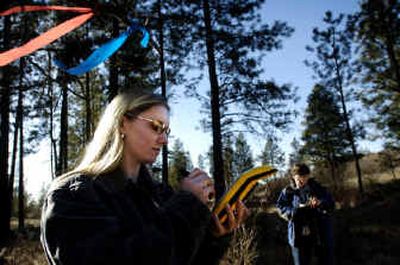A natural attraction

Boots required.
Those are welcoming words for those who want to earn a paycheck working outdoors.
Every year Spokane Community College graduates about 30 students from its forestry program.
While most of those students go to work for various government agencies and begin as seasonal workers, opportunities are growing, says instructor Monica Spicker.
Considers this, she says: “Of the 90,000 employees within the Interior Department and the Forest Service, about half are expected to retire by 2007.”
Half?
Spicker says it’s true, as baby boomers reach years-of-service requirements to qualify for federal retirement perks.
Furthermore, undergraduate enrollment in natural resource science programs has fallen by 40 percent in the past decade.
Add it together and a career in natural resources holds real promise.
Jared Langford, 28, was working for a mechanical design firm in Yakima when he decided it was time for a change.
“Five years sitting behind a desk was enough,” he says. He had joined a Search and Rescue team and decided he wanted to work outdoors.
He interned with timber company Boise Cascade, beating out students from several area schools for the job.
This summer he plans to take a job with the Forest Service, anticipating a busy fire season and the high pay that comes with it. Later, Langford says he will enroll at a university to further bolster his chances at nailing the right job.
While some students enrolled in the SCC natural resources program move on to pursue a bachelor’s degree, many go right to work after earning a two-year associate’s degree. The natural resources program includes four fields: forestry, water resources, soils, and parks and recreation.
Graduates leave the natural resources program with a keen understanding of computer mapping programs and the use of GIS (geographic information systems) technology.
It helps to have a background in math and science and the expectation that working outdoors isn’t about taking walks and watching birds.
“Sometimes people come in here with this romantic notion,” Spicker says. “That may be why we lose a third of our students before the first year is out.”
The pay varies. Those in the water resources program can often get higher paying jobs in fisheries and at water quality agencies. The jobs may include streamside rehabilitation for salmon and trout species, work at fish hatcheries or wetland restoration.
In the forestry program, graduates often take initial jobs as forest technicians, timber cruisers, forest firefighters, and land consultants. Students also conduct field studies, taking inventory of trees and animals to help land managers draft plans for timber harvests, housing developments, conservation easement considerations and habitat restoration.
“Anyone in our program who wants a job can at least get a seasonal job around here,” Spicker says, “and if they succeed, it often leads to full-time work.”
Indeed, the U.S. Department of Labor lists environmental science and protection among the fastest growing occupations.
The pay can be as low as $11.50 an hour for seasonal jobs with the federal government. However, pay is usually better for jobs with state agencies and private companies. Depending on the jobs, pay can hit $16 an hour quickly.
“If someone is interested in working in the field,” Spicker says, “we can help.”